All sites are different
And that’s why it’s quite difficult to teach a checklist of “quick win SEO checks”. In fact, I suspect it’s unwise to rely on checklists when you’re churning through an SEO audit. The wonderful power of proper experience means that with practice, you just know where to look and what kinds of things to check for. All without a predetermined checklist of items to evaluate.
As I’ve thought about how to teach the “quick win” SEO process, I’ve come to realise the right way to help SEOs learn is to teach a mindset. By learning where to look and how to recognise a potential area for performance gain, rather than blindly following a checklist, you’re unlocking a lot of opportunities and a special place where SEO becomes intuitive.
You’ve read posts about technical checklists, dealing with duplicate content and performing basic site audits.
That’s an approach that can get you so far, but for me, big gains can be found as you investigate the history of a site.
It’s all in the history
Builtvisible.com is a good example site to choose because it’s seen quite a turbulent past. That means there are always lots of things to improve.
I really enjoy managing our site, and especially managing our overall SEO, it’s a great playground to manage tests and learn new things.
We’ve seen a lot of changes:
From multiple domain migrations, from legacy inbound links, a successful re-brand, a penalty and subsequent recovery, even annoying comment spam tripping safe search filters, switches to HTTPS, back to HTTP and back to HTTPS again, it’s a pretty exciting and enjoyable task staying on top of our SEO.
I’ve spent the last few months gradually finding improvements to make. While those improvements are specific to this site, I wonder if there’s some value sharing what I found.
Make sure you know your domain history
This site has seen 3 different domain iterations. SEOgadget.co.uk, SEOgadget.com and finally, Builtvisible.com.
That means there’s a legacy of inbound links (more on this later), a legacy of page level redirects (more on that in a moment) and a legacy of domain redirects.
Some months ago, I found there was a performance gain to be found by simply making sure that you’re not just 301 redirecting your old domain, but that you’ve also used Google Webmaster Tools “Change of Address” feature.
After migrating from SEOgadget.co.uk to SEOgadget.com, our site performance simply wasn’t as good. A good part of this performance drop was recovered after re-registering the domains in GWMT and setting the change of address correctly:
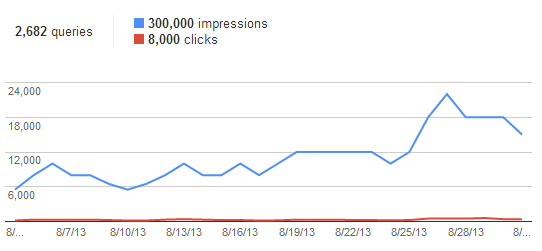
Searchmetrics confirmed this change had significantly improved our organic performance:

What do you know about the domain portfolio owned by your client?
If you’re just starting out on a new project with a new client or in a new in-house team, it’s hard to know where to look to answer questions like this.
Fortunately, there are tools out there that can help you find domain names that might be registered by your client that they may not necessarily be aware of.

Use Domaintool’s Whois Tool to get the email address associated with the domain:

And then paste into a free reverse whois tool like Whoisology to get a list of domains associated with the account.
Understand your page level redirects
By “page level redirects” I’m referring to pages that historically accrued a lot of links that now redirect. In our case, I found some opportunities to conserve link equity by reducing multiple redirect hops. I should say that I think redirects, on the whole, should be avoided and multiple redirects are really, really terrible.
So here’s a good example of an often missed opportunity: the original Schema Guide hosted on SEOgadget.com:
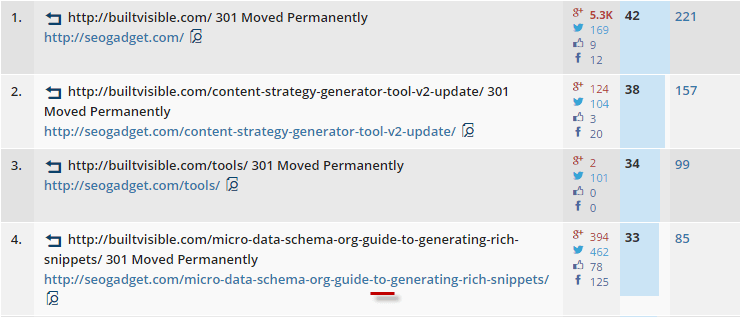
Unless you test each individual redirect (by clicking, and taking a look at the output on Ayima’s Redirect Path Checker, you’re going to miss this:
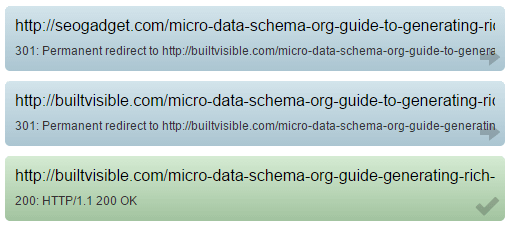
A glorious opportunity: a completely unnecessary redirect hop. Dig deeper and new opportunities come out of the woodwork, like the amazing legacy link from Oracle below to a classic (and now removed!) post on Virtualbox that happened to be passing through another 3 redirect hops:

While we’re on the subject of redirects, don’t forget to check for links to your “www” subdomain. People don’t always link to the correct web address!
Obviously, there’s a diminishing return to checking for these opportunities, it takes time and the gains return less and less value. With that said, I think there’s a huge power to understanding your Top Pages, and a careful, line by line investigation into reports like this can make an important difference to the performance of your site:

And drilling down by your best inbound links can yield important opportunities too:
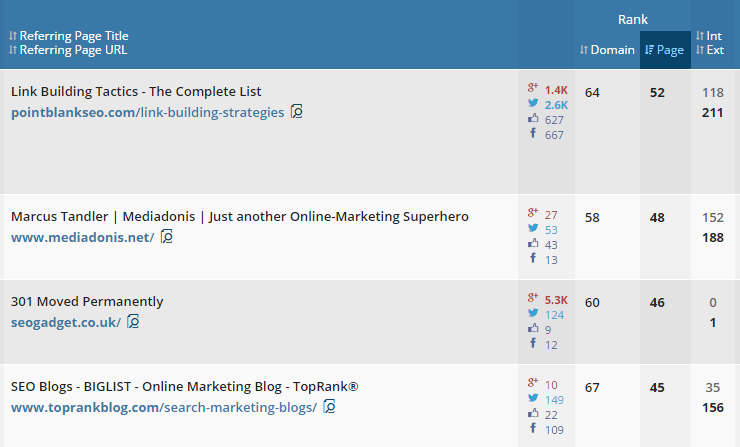
Realign your best links
As I’ve said, we have a legacy of content that has, over time, acquired links from all over the internet. In my opinion, 301 redirects are best avoided. There’s just something about legacy content that only has external links via a 301 that leaves it likely to underperform or worse, be easily copied and outranked.
So it makes sense to me to put some effort into realigning your best links.
Firstly, I’ve observed that a page with 301 redirecting links (internal and external – more on internal in a moment) alone doesn’t rank well – if at all. Case in point, an early blog post about HTML5 examples didn’t rank until I solved an internal links problem – our internal links were all 301s from inside the article content, and tag/category links were so weak to this page that I really don’t think they were making any difference. While there were plenty of external links, they were all 301s too. When I fixed the internal links to point directly to the page, it began to rank again.
Secondly, I think there’s just a general equity loss via a 301. It makes sense then, to experiment with this yourself but for us, I’ve found it’s a worthwhile exercise to update external links too. Just a few friendly outreach emails, and it turns out people can often be very helpful and willing to help:

Thirdly, I think it makes sense to realign the anchor text of some of your better inbound links. Why risk over optimised inbound anchor text when we know branded is a safer bet? That’s exactly what I did when we had this classic “Server Header Responses 101” link updated.
Update and improve your internal links
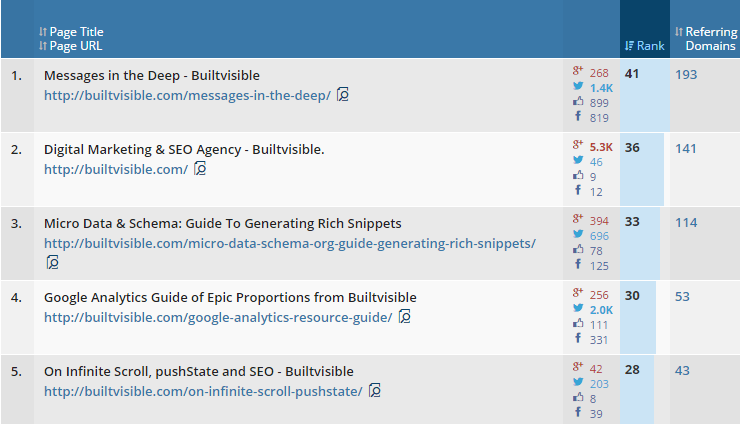
There are a wealth of internal resources on your site. Carefully built over time, each pages has valuable link and traffic equity, but, because of the linear nature of site updates, your internal links can often need a review.
Generally, I tend to focus on developing internal links on:
- Top linked to pages
- Top landing pages
Linking to:
- Pages that have a high search traffic potential (ranking ~4th/5th)
- Pages that don’t have many internal links
Identify pages that don’t have many internal links – there’s gold in the internal links report in Google Webmaster Tools (“Search Traffic > Internal Links”, sort by lowest number of internal links). Improving potentially valuable pages with extra internal links can make a big difference to your long tail.
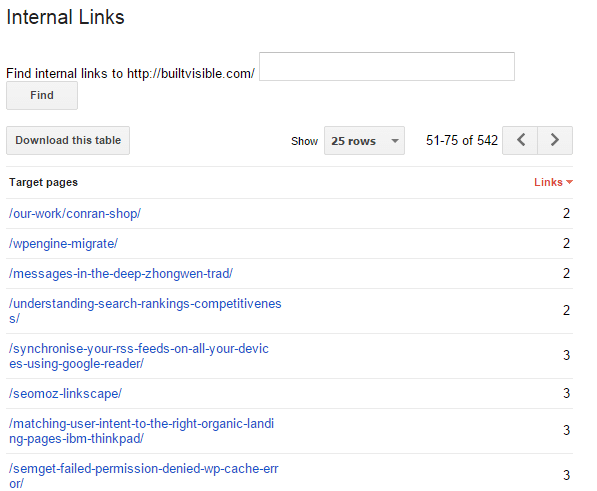
Your site speed
Honestly, I think this is a huge thing to improve if you can. Optimising your images with tools like TinyPNG, improving your DNS latency, your server response time, reducing the size of any and all files you’re serving and using a decent CDN / caching strategy makes a lot of sense.
We moved to Amazon’s Route 53 DNS service and WP Engine to tease out as much performance as possible.
This was the result:

Often we’re seeing a 100% improvement in average page load. This is good.
Start simple
In this post, I wrote about the value of targeting valuable pages and redeveloping them. As we speak we’ve had a 3rd update of Dan’s Schema Guide, and this time around it got a Hacker News front page.
Identifying pages that have performed well in Analytics and in Social for even the most basic formatting and content updates can yield significant gains over time.
One final note
I get a lot of joy out of charts like this, the outcome of managing a site for SEO performance and a constant pursuit of those important marginal gains:

Finding gains like this on a site is a individually tailored task and it takes time. In my opinion, an SEO should be curious and keen to investigate the meaning of every report and piece of data he or she can get hold of. To me, there’s so much value to be gained in understanding the history of a site. With the importance of maintaining a site technically acknowledged, in my opinion, knowing your history can do the rest of the work. I think that has always been the very essence of search engine optimisation, and certainly, I think it’s the most fun aspect. I also hope that it’s never a skill we lose.
Get the presentation
I gave this presentation at the recent Friends of Search conference in Amsterdam. Take a look over on slideshare!
What are your low effort, big return wins for SEO?


Dan Shure
Yup, THIS. It’s like improvising music really. You plan and plan and plan with years of practice and experience. Yet when “showtime” comes you have to forget everything in a way – clear your mind and ego out of the way and be open to that moment.
I think redirect chains are terrible for SEO. Really bad. This little guide I wrote on different ways to find them with Screaming Frog may help sites that are old, large, old and large and/or have gone through migrations like yours has! https://www.evolvingseo.com/2013/10/09/how-to-find-fix-redirect-chains/
Ryan Stewart
Anything within your control (i.e. technical SEO) are easy wins for me. Aligning your content with the right keywords, titles, image optimization and internal link structure are often overlooked because they can be a pain in the ass – but they’re so important!
James Hughes
Hey Richard,
Great informative post. With all the new mediums like social media sites and other methods, online marketers lose focus. They tend to forget the basics. Thanks for sharing and reminding how important SEO basics are.
Regards.
Richard Barker
Some fantastic tips here! Thanks for the article and you’ve nearly got a great name there if you change a few letters :)
Richard
https://www.harrisonmann.co.uk